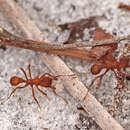en
names in breadcrumbs


Trachymyrmex is a genus of fungus-growing ants in the subfamily Myrmicinae. The genus is mainly tropical in distribution, with most species being found in Central and South America.[3]
The queens of the species appear to mate with only one male on their nuptial flight.[4]
A number of species were moved from Trachymyrmex based on molecular phylogeny by Solomon et al. 2019. Of the species formerly included, nine were retained in Trachymyrmex, while 31 of the species were moved to the new genus Mycetomoellerius, and an additional nine moved to Paratrachymyrmex.[5]
Trachymyrmex species
Species moved to Mycetomoellerius
Species moved to Paratrachymyrmex
Trachymyrmex is a genus of fungus-growing ants in the subfamily Myrmicinae. The genus is mainly tropical in distribution, with most species being found in Central and South America.
The queens of the species appear to mate with only one male on their nuptial flight.